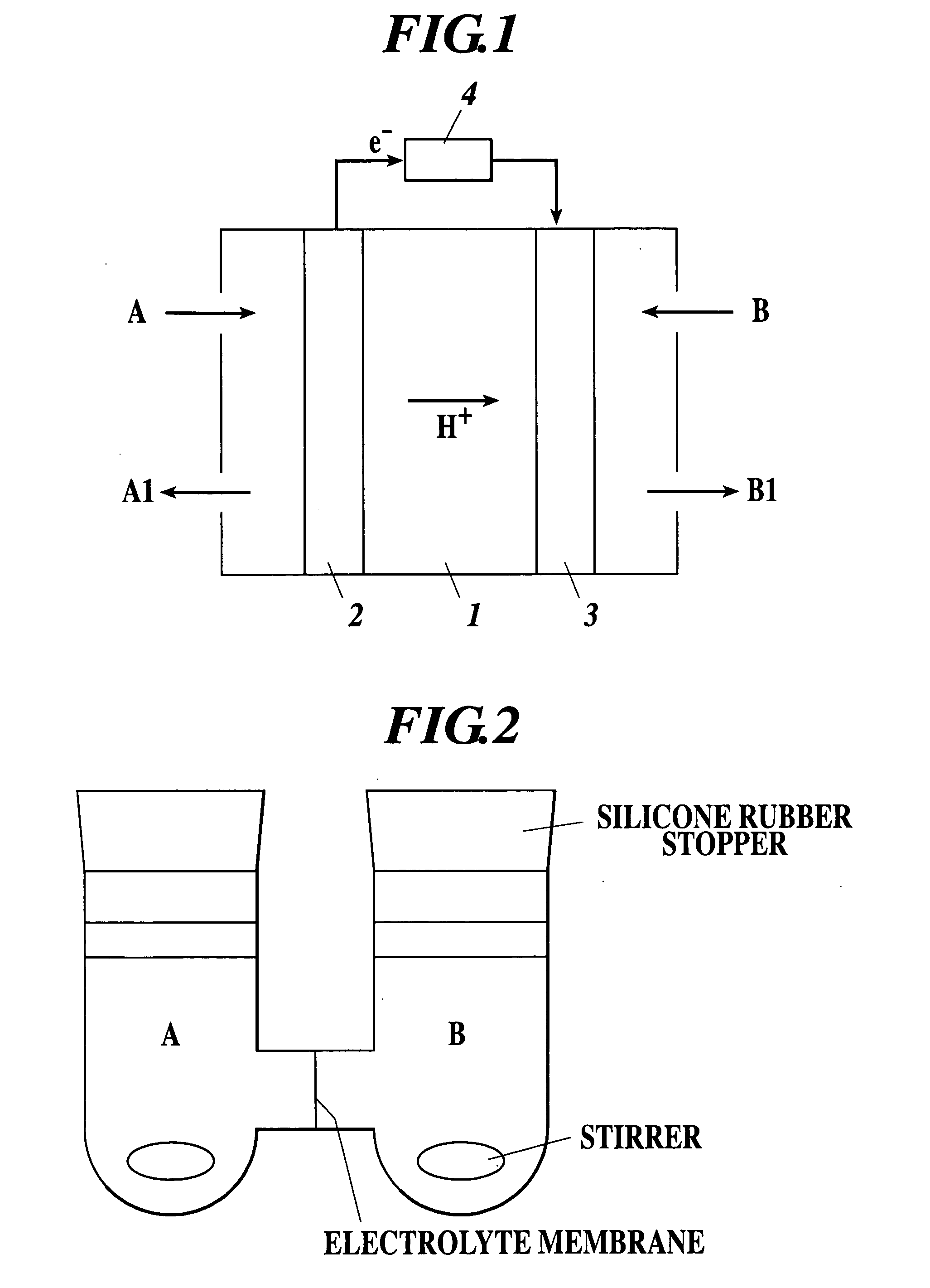Proton conductive electrolyte membrane, solid polymer fuel cell and method for producing proton conductive electrolyte membrane
a proton conductive electrolyte and electrolyte technology, applied in the direction of cable/conductor manufacturing, fuel cell details, final product manufacturing, etc., can solve the problem of difficult to obtain products with sufficient proton conductivity performance, and achieve excellent performance, physical strength is sufficient, and the effect of reducing the thickness
- Summary
- Abstract
- Description
- Claims
- Application Information
AI Technical Summary
Benefits of technology
Problems solved by technology
Method used
Image
Examples
example 1
(1) Production of Proton Conductive Electrolyte Membrane
(1.1) Preparation of Porous Membrane
(1.1.1) Preparation of Porous membrane No. 1
[0087] Mixture of polystyrene particles (trade name: Polystyrene 90 produced by Seradyn Corp., average particle size of 83 nm) and colloidal silica (trade name: Snowtex 10 produced by Nissan Chemical Corp., primary average particle size of 20 nm), which contained 20% of polystyrene particles and 80% of colloidal silica by volume, was agitated and dispersed in a dilute aqueous solution of a surfactant by using a high speed homogenizer. The concentration of the dispersion liquid was brought to 20% by mass.
[0088] Subsequently, filtration was performed with a membrane filter having a pore size of 0.025 μm by using a vacuum suction filter manufactured by Advantec Corp. The filter paper was dried and put into a constant temperature oven of 800° C. to be baked, and thus “Porous membrane No. 1” was prepared.
(1.1.2) Preparation of Porous Membranes N...
example 2
[0101] The same dispersion liquids as Porous membranes No. 3 to 11 prepared in Example 1 were prepared. Respective dispersion liquids were applied onto a polyethylene terephthalate support by using a bar coater so that the thicknesses after drying became 50 μm, and were dried to produce “Porous membranes No. 203 to 211”.
[0102] In the same way as Example 1, the membranes were filled with a proton conductive organic material to produce proton conductive electrolyte membranes and measure the proton conductivities, methanol permeabilities and membrane strengths.
[0103] Results are shown in Table 3.
TABLE 3MethanolElectrolyteProtonblockmembraneconductivitypercentageMembraneNo.S / cm(%)strengthRemarks2034.2 × 10−23.0 × 10−5◯Presentinvention2044.5 × 10−27.6 × 10−5ΔPresentinvention2054.6 × 10−23.0 × 10−5◯Presentinvention2064.6 × 10−23.0 × 10−5◯Presentinvention2074.9 × 10−24.0 × 10−5◯Presentinvention2085.2 × 10−24.3 × 10−5◯Presentinvention2094.6 × 10−24.0 × 10−5◯Presentinvention2103.9 × 10−2...
example 3
[0105] Membrane electrode assemblies (MEA) were produced with the use of the proton conductive electrolyte membranes (Electrolyte membranes No. 1 to 12) by the following method.
(1) manufacture of electrode
[0106] After polytetrafluoroethylene (PTFE) water-repellent treatment was applied to carbon fiber cross media, the media were coated with a carbon black dispersion liquid containing 20% by weight of PTFE and baked to produce an electrode substrate. An anode catalyst coating liquid comprising Pt—Ru supporting carbon and a Nafion (produced by DuPont Corp.) solution was applied onto the electrode substrate and dried to produce an anode. A cathode catalyst coating liquid comprising Pt supporting carbon and a Nafion (produced by DuPont Corp.) solution was applied onto the electrode substrate and dried to produce a cathode. (2) production of membrane electrode assemblies (MEAs) and evaluation of current-voltage characteristics of the MEAs.
[0107] Each of Proton conductive electrolyte ...
PUM
| Property | Measurement | Unit |
|---|---|---|
| particle size | aaaaa | aaaaa |
| particle size | aaaaa | aaaaa |
| pore size | aaaaa | aaaaa |
Abstract
Description
Claims
Application Information
 Login to View More
Login to View More - R&D
- Intellectual Property
- Life Sciences
- Materials
- Tech Scout
- Unparalleled Data Quality
- Higher Quality Content
- 60% Fewer Hallucinations
Browse by: Latest US Patents, China's latest patents, Technical Efficacy Thesaurus, Application Domain, Technology Topic, Popular Technical Reports.
© 2025 PatSnap. All rights reserved.Legal|Privacy policy|Modern Slavery Act Transparency Statement|Sitemap|About US| Contact US: help@patsnap.com

